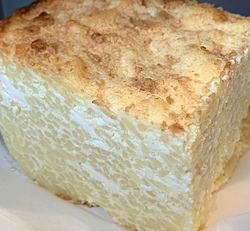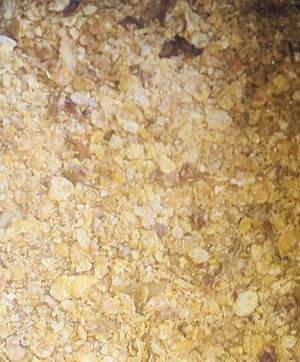Noodle kugel facts for kids

Noodle kugel (לאָקשן קוגל lokshen kugel)
|
|
| Type | Kugel or casserole |
|---|---|
| Course | Side dish |
| Place of origin | Jewish from Central Europe. Today mostly in Israel, the United States, France, Canada, United Kingdom, Australia, Argentina, South Africa, and other communities in the Jewish diaspora. |
| Created by | Ashkenazi Jews |
| Serving temperature | Cold, room temp, sometimes warm |
| Main ingredients | Lokshen noodles, eggs, sugar, vanilla, cinnamon, oftentimes raisins or other dried fruit, can be made with dairy or pareve ingredients, if dairy: cottage cheese, sour cream, cream cheese, butter, milk, ricotta, farmers cheese are common, if pareve: cooking oil or margarine, applesauce, toppings include cornflakes, streusel and crushed graham crackers |
| Variations | Kugel Yerushalmi |
Noodle kugel (לאָקשן קוגל lokshen kugel), also called lokshen kugel, is a yummy baked dish. It's a type of casserole that comes from Ashkenazi Jews, who are Jewish people from Central and Eastern Europe.
This dish is usually served as a side dish. It's very popular during Shabbat (the Jewish day of rest) and other Jewish holidays. Noodle kugel is made with lokshen noodles, which are like thin egg noodles. It can be made with dairy ingredients like cheese and sour cream, or with pareve ingredients. Pareve means it has no meat or dairy, so it can be eaten with either.
While many noodle kugels are sweet, some are only slightly sweet or even savory. They can be baked in a big dish or in smaller, individual ones. Sometimes, people add raisins or other dried fruit to kugel. For toppings, people often use a cinnamon streusel or crushed cornflakes or graham crackers.
Contents
What is Noodle Kugel?
Noodle kugel is a baked dish that's a bit like a casserole or a pudding. It's made with egg noodles, eggs, and often sugar, vanilla, and cinnamon. Depending on the recipe, it can also include dairy items like cottage cheese, sour cream, or cream cheese. If it's made pareve, it might use oil or applesauce instead of dairy.
This dish is very flexible! You can eat it cold, at room temperature, or even warm. It's a comfort food for many families.
Where Did Kugel Come From?
The word kugel comes from the Yiddish language. It means 'sphere' or 'ball'. Long ago, kugel might have been round balls of dough. These were cooked inside a traditional Shabbat stew called cholent. The dough balls would soak up the stew's flavors. Over time, around the 13th century, kugel changed into the baked dish we know today.
Kugel or Kigel?
Different groups of Jewish people say the word a bit differently. Jews from Lithuania and nearby areas, called Litvaks, say kugel. But Jews from Poland and Ukraine, called Galitzianers, say kigel. In the United States, the kigel pronunciation became less common. This was because it sounded a bit like a different word.
Sweet or Savory?
There are two main types of noodle kugel: sweet and savory.
- Lithuanian Jews, or Litvaks, often preferred savory dishes. Their kugels might have more salt, pepper, and caramelized onions.
- Polish Jews, or Galitzianers, loved sweet dishes. They are known for creating many of the sweet noodle kugels.
When Jewish people moved to North America from Eastern Europe, more Galitzianers came than Litvaks. This meant that sweet noodle kugel became much more popular in American Jewish cuisine. Today, sweet noodle kugel is the most common type you'll find. It's a favorite dish for Jewish holidays and Shabbat. You can also find it in many Jewish delis and restaurants.
Tasty Toppings
Some people like their noodle kugel plain. They enjoy the crispy top of the noodles that get crunchy when baked. But many others love to add different toppings!
Popular toppings include:
- Crushed cereals: Like cornflakes or Frosted Flakes.
- Crushed graham crackers: These are especially good with a sweet, cheesy kugel. It makes it taste a bit like a New York cheesecake.
- Streusel: This crumbly topping was first made popular by German Jews. It's like the topping on a crumb cake.
- Crumbled cookies: Such as Nilla Wafers, gingersnaps, or Oreos.
- Pecan pralines: This topping is popular, especially among Jewish people in the American South.
- Breadcrumbs: Savory noodle kugels are sometimes topped with breadcrumbs, similar to macaroni and cheese.
Cornflake Topping
A cornflake topping became popular in the United States in the early 1900s. It's usually used on sweet kugels that contain dairy. This topping mixes American and Ashkenazi Jewish cuisine.
To make it, cornflakes are crushed, then mixed with sugar, cinnamon, and melted butter. This mixture is spread on top of the kugel before or during baking. It's still a very popular topping, especially in the East Coast and Midwestern United States.


